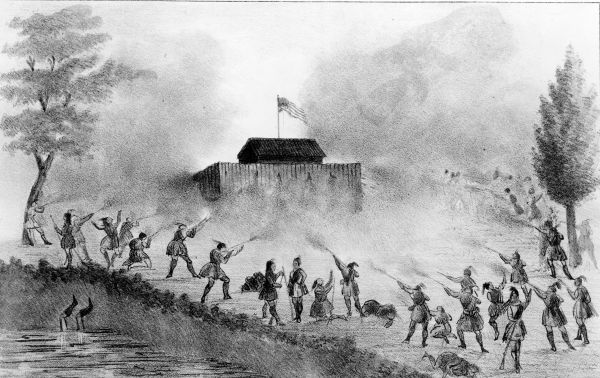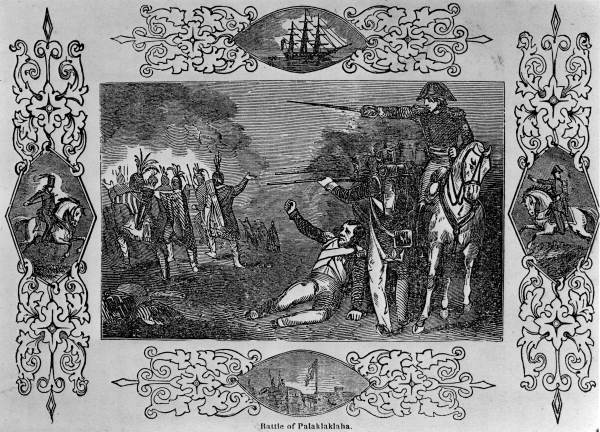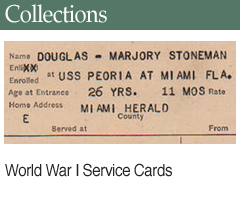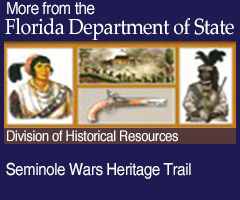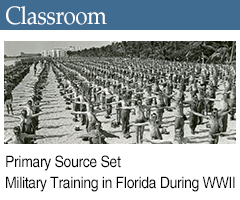Guide to Military Records and the Wartime Experience
at the State Archives of Florida
Seminole Wars, 1817-1858, and the Mexican-American War, 1846-1848
Contents
The Seminole Wars were three military conflicts between the United States Army in Florida and native Seminoles, occurring between 1817 and 1858. When Florida was under British rule, the British often incited Seminoles against American settlers who migrated south into Seminole territory. These old conflicts, combined with the safe haven Seminoles provided to enslaved Blacks, caused the U.S. Army to attack the tribe in the First Seminole War (1817-1818). Forces under General Andrew Jackson invaded Spanish Florida, attacked several key locations, and pushed the Seminoles farther south.
The Second Seminole War (1835-1842) was the fiercest war waged by the U.S. government against American Indians. It began when U.S. forces arrived in Florida to enforce the terms of the 1832 Treaty of Payne's Landing, which required Seminoles to give up their Florida lands within three years and move west. The United States spent more than $20 million fighting the Seminoles and forcibly removed 3,824 of them from their lands. The war left more than 1,500 soldiers and uncounted Seminoles and American civilians dead. Furthermore, the obvious duplicity of the U.S. government's tactics marred American Indian-white relations throughout the country for future generations.
While still reeling from the effects of the Second Seminole War, Florida became the 27th state of the U.S. in 1845. One year later, the U.S. became embroiled in an armed conflict with Mexico over the Republic of Texas and its Mexican boundary. Faced with their first chance to fight for the United States and obliged to provide support, Floridians mustered 390 volunteer soldiers to assist against Mexico. Although the U.S. emerged victorious when the Mexican-American War ended in 1848, the high casualty rates and monetary cost undermined the acquisition of new territory and heightened sectional tensions on both sides.
A Third Seminole War broke out in 1855, when conflicts—largely over land—arose between whites and some Seminoles who remained in Florida. Constant military patrols and rewards for the capture of Native Americans reduced the Seminole population to about 200 when the Third Seminole War ended in 1858.
The State Archives has a variety of records documenting United States military involvement in the three Seminole Wars and the Mexican-American War and the experiences of Florida's citizens at the time. The records include traditional military records such as muster rolls as well as financial records, maps, diaries, letters and other personal papers. Unfortunately, there is very little documentation of the Seminoles' experiences, and what exists is primarily from the point of view of the agencies attempting to remove them.
Government Records
S162
Indian War Claims Commission
Records, 1849-1926
1.75 cubic feet
The Indian War Claims Commission was responsible for examining and validating warrants issued in 1861 for services rendered during the Seminole War. These records consist primarily of correspondence and claims on warrants. The correspondence deals with Florida’s attempts to settle with the federal government for reimbursement; the claims contain required documentation for the Commission, which may include letters of inquiry and complaint, sworn affidavits of service, and other supporting information. Also included in this series are muster rolls used to determine claim validity, a small selection of Commission reports and minutes, and informational publications describing the background of the Indian War Claims controversy.
S608
National Archives
Compiled Service Records of Volunteer Soldiers who Served in Organizations from the State of Florida during the Florida Indian Wars, 1835-1858
63 microfilm reels
These compiled service records typically consist of a jacket-envelope containing card abstracts of entries relating to a soldier that usually show his rank, the unit in which he served, term of service, time and place of enlistment and promotions or demotions received. Certain organizations may also include information regarding his activities within the unit, dates of leave (either official or unofficial), illnesses and death. If a soldier was a member of a mounted organization, the abstracts also show the value of his mount and his equipment. Unit caption cards include information on when, where, and under whom the unit operated and often bear a copy of certification and endorsement, while “record of events” cards describe the activities of each unit from initial organization to disbandment.
S679
Florida. Governor William D. Moseley
Correspondence, 1845-1849
1 cubic foot
William Dunn Moseley was Florida’s first governor under statehood, elected in 1845. While he was governor, the Mexican War began and skirmishes with the Seminoles continued. This series contains the official correspondence of Governor Moseley reflecting the official, constitutional and political duties of the Office of the Governor. The series consists mainly of incoming and outgoing correspondence filed by general subject area, agency or organizational name, or county name.
S973
National Archives
Index to Compiled Service Records of Volunteer Soldiers Who Served During Indian Wars and Disturbances, 1815-1858
42 microfilm reels
This microfilm publication contains an alphabetical card index to the compiled service records of volunteer soldiers who served in various Indian wars or participated in the quelling or solving of incidents then referred to as Indian disturbances. Each index card gives the name of a soldier, his rank, and the name of the war or disturbance, as well as the unit or units in which he served.
S975
National Archives
Memoir of Reconnaissances with Maps During the Florida Campaign, 1854-1858
1 microfilm reel
This microfilm publication contains summaries of reports and accompanying maps received by Headquarters, Troops in Florida (1854-1856), and Headquarters, Department of Florida (1856-1858). These reports, filmed with maps that accompanied the originals, describe the various map-producing activities of the Army in Florida, including surveying, exploring, road-building and scouting. They contain extensive comments about the terrain and other topographic features of Florida's coastal and inland geography, field notes on the geology of the state and remarks about its flora. The reports also include many references to Indian life, diet, trails and villages. The accompanying maps are also largely the result of field observations and typically indicate prominent rivers and lakes, military posts and roads, forts, and the location of Indian trails and villages.
S1106
National Archives
U.S. Department of State Territorial Papers, Florida Series, 1777-1824
11 microfilm reels
This microfilm publication consists of 11 volumes containing communications addressed mainly to the United States Secretary of State from federal officials in Florida and letters from private individuals residing in Florida. Some of the earlier documents deal with the attempted seizure of East Florida (1811-1812) and the First Seminole War (1817-1818). Most of the collection deals with the cession of Florida and Andrew Jackson's military government.
S1109
National Archives
Letters Received by the Office of Indian Affairs Relating to the Florida Superintendency, 1824-1853
6 microfilm reels
This microfilm publication contains letters written mainly to the Secretary of War or the Commissioner of Indian Affairs from Florida governors, Indian agents, United States military personnel and private citizens. The correspondence deals generally with Indian attacks, activities during the Second Seminole War, and the negotiations and eventual removal of the Seminoles to the west. The correspondence from the Superintendent of Seminole Emigration specifically deals with the efforts of the federal government to remove the Seminoles from Florida. The correspondence of the Reserves mainly contains papers relating to administrative matters of military personnel.
S1123
National Archives
Letters Sent, Registers of Letters Received, and Letters Received by Headquarters, Troops in Florida and Headquarters, Department of Florida, 1850-1858
10 microfilm reels
The letters in this series detail the incidents of small-unit warfare against the Seminoles and include reports of Indian attacks, military operations, scouts and marches, and attempts to negotiate. Among the records are reports of surveying parties that charted the wilderness of interior Florida with maps to construct roads and fortifications. Also included are letters that describe garrison life on military posts in Florida that provide valuable insights into military life on the southeastern frontier just before the Civil War.
S1277
Office of the Adjutant General
Original Florida Territorial Muster Rolls, 1826-1849
1 microfilm reel
The first state militia companies organized under the Florida Militia Law of 1822, adopted shortly after the United States’ acquisition of Florida. This series contains muster rolls for the Florida State Militia units. It includes several from the 1820s organizational period, while the majority date from the Second Seminole War. In most instances the rolls contain the name and rank of the soldier, when and where they enrolled, and remarks. Also included is an abstract of the annual strength return for 1845.
S1281
Office of the Adjutant General
Seminole War Muster Rolls of Florida Militia, 1836-1841, 1856-1858
10 volumes
The volumes in this series contain photostatic copies of muster rolls for Florida militia volunteer units for the Second and Third Seminole Wars. The rolls list the name, age and rank of the soldier, the date and place of enlistment, information regarding pay, and general remarks. Most of these units are independent companies that may have served in more than one period of any or all three wars.
S1282
Florida. Office of the Adjutant General
Mexican War Muster Rolls of Florida Independent Companies, 1847-1848
1 volume (1 microfilm reel)
Of the five companies mustered into service for the Mexican-American War, only three saw action in Mexico; the other two served at Fort Brooke in Tampa. The muster rolls in this volume contain the following information: name, rank and age of soldier; when, where and by whom were they enrolled; when, where and by whom were they mustered into service; when they were last paid; number of miles travelled; subsistence and forage furnished by themselves; clothing due to soldier; value of equipment, arms, etc. received from the United States; value in dollars of horses and horse equipment; and remarks.
S1409
National Archives
Lists of the Adjutant General's Office for Carded Records of Military Organizations: Revolutionary War through Philippine Insurrection, "The Ainsworth List," 1817-1818, 1835-1841, 1857-1858
1 microfilm reel
This series contains Roll 39 of The Ainsworth List, a compilation of muster rolls of military organizations that served during various conflicts from the Revolutionary War to the Philippine Insurrection. Roll 39 contains records relevant to the Creek War, the First Seminole War, the Second Seminole War and the Third Seminole War for the states of Florida, Alabama, Arkansas and the District of Columbia. An index lists the military organizations involved, followed by individual cards that lists the dates and locations that the organization mustered into and out of service, the length of service, the number of men in the organization and other related notes.
Personal and Family Papers
M72-7
Gamble Family History Notes, 1898
1 microfilm reel
The Gambles were a prominent Tallahassee family for generations. This collection is a compilation of family history notes and transcriptions of various documents relating to events in the family's past. The collection contains Revolutionary War records of Robert Gamble and the Seminole War (particularly the Battle of Withlacoochee) journal of Major Robert Gamble.
M75-103Maps of Florida, 1829-1888
9 items
The maps in this collection represent the entire state of Florida or parts of it. Four maps cover the whole state in four separate years: 1834, 1837, 1846 and 1855. Other maps are sectional, representing East Florida (1840) and South Florida (1856, 1888). The U.S. military drew the 1856 map, and it details the area west of Lake Okeechobee where much of the fighting in the Seminole Wars took place.
M82-1Richard Keith Call Correspondence, 1791-1794, 1825-1849
.25 cubic foot
Richard K. Call was a Territorial Governor of Florida from 1836 to 1839, and again from 1841 to 1844. During his first term, Call led the army that defeated the Seminoles in the Second and Third Battles of Wahoo Swamp. This collection contains correspondence that discusses the determination of land ownership; the disposition of the territorial archives; the First and Second Seminole Wars, including the Battles of Withlacoochee, Fort Drane and Wahoo Swamp; and other political matters.
M82-4Richard Keith Call Journal, 1861
.25 cubic foot
This typescript copy of Call's reminiscences begins with a depiction of Call's early life before coming to Florida. Much of the account deals with his military career during the Creek War and the First and Second Seminole Wars. He details his relationship with Andrew Jackson at the Battle of Withlacoochee, as well as his leadership role as territorial governor and commander of U.S. troops fighting the Seminoles. Call includes some information on his term as Florida's territorial governor. The journal ends with Call's service in the Second Seminole War.
M86-12Thomas Sidney Jesup Diary, 1836-1837
1 volume
General Thomas Sidney Jesup was the third general to command Florida troops during the Second Seminole War. This collection consists of the campaign diary of General Jesup while commanding his first campaign from October 1, 1836 to May 30, 1837. The diary details the routine of a commander issuing orders, requisitioning supplies and directing troop movement. It also documents Jesup’s relationship with the War Department and the state militia, and his communications with the Seminoles on their behalf. The diary reflects the hardships and problems Jesup and his men encountered in searching for the elusive Seminoles in the extensive Florida wilderness, as well as Jesup’s personal thoughts about the campaign.
M89-32Daniel H. Wiggins Diaries, 1816-1834, 1838-1841, 1862
.50 cubic foot
Daniel H. Wiggins moved to Florida from Annapolis, Maryland, in 1838 and established a millwright trade in Jefferson and Leon counties. This collection contains several of Wiggins’ diaries that document his early life in Annapolis and his later experiences in Florida. Wiggins is prolific in detail about his life in and around Leon, Jefferson and Gadsden counties. He relates information about Indian disturbances in and around Jefferson and Leon counties during the Second Seminole War. He describes his travels, the people he encountered and his observations about the growing territory.
N2017-20Richard Keith Call Letters, 1839-1840
1 folder
This collection includes two letters written by Richard Keith Call. The first letter, sent to President Martin Van Buren in 1839, concerns the condition of Florida and its inhabitants during the Second Seminole War. The second letter, from Call to Major General Thomas Jesup, discusses a conflict between Call and the Secretary of War and what he describes as a "deliberate attempt" by the government to "disgrace" him.
N2017- 61Parkhurst Family Letters, 1846-1847, 1886, 1897
.25 cubic foot
In 1846 Edwin and Ellen Parkhurst of Pennsylvania went to Pensacola, Florida, on a business trip during the Mexican-American War, returning home in 1847. This collection consists of letters the Parkhursts sent to family members during their trip to Pensacola. The letters discuss their experiences with traveling to and in Florida; the ongoing Mexican-American War, such as the Siege of Veracruz and celebration at the Navy Yard; and their arrangements for returning home.
N2017-108William Alburtis Letter, 1840
1 folder
Captain William Alburtis was born in West Virginia and was stationed in Florida during the Second Seminole War. He died on March 11, 1847, fighting in the Battle of Veracruz during the Mexican-American War. This letter is from Alburtis in Palatka, Florida, to his mother in Martinsburg, West Virginia, on July 22, 1840. The letter discusses Alburtis' experience as a soldier during the Second Seminole War, as well as personal affairs.
N2017-109Second Seminole War Papers, 1837, 1840-1843, 1880
.25 cubic foot
This collection consists of correspondence with general discussions of military affairs and soldier experiences, and a bill authorizing payment to Captain George E. McClellan's Company of Volunteers for services rendered in the Seminole War.
N2017-115Third Seminole War Letters, 1856-1857
1 folder
This collection consists of four transcriptions of letters to Governor James E. Broome during the Third Seminole War, discussing war events, volunteer efforts and civilian situations across the state.
N2019-13Captain Adam Gramling Papers, 1835, 1837, 1839-1840
1 folder
This collection includes four items related to Captain Adam Gramling of Tallahassee, Florida. There are three commissions of Gramling: two as captain of the militia dated 1835 and 1837 and one as a Justice of the Peace in Leon County in 1840. Also included is the 1839 roster of Company A of the Centerville Militia that Gramling commanded.

 Listen: The Latin Program
Listen: The Latin Program